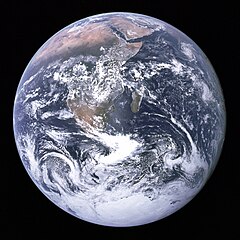Earth, also known as Terra, and Tellus mostly in the 19th century, is the third-closest planet to the Sun. It is the largest of the solar system's terrestrial planets, and the only planetary body that modern science confirms as harboring life. Scientific evidence indicates that the planet formed around 4.57 billion (4.57×109) years ago, and shortly thereafter (4.533 billion years ago) acquired its single natural satellite, the Moon.
The Earth consists of several atmospheric, hydrologic, and mainly geologic layers. Its components are the atmosphere, the hydrosphere, the crust, the mantle, and its core. The biosphere is a tiny layer in this composition and is usually not considered part of the physical layers of the Earth.
The geologic component layers of the Earth are located at the following depths below surface:
0 to 60 km - Lithosphere (locally varies between 5 and 200 km)
0 to 35 km - Crust (locally varies between 5 and 70 km)
35 to 60 km - Uppermost part of mantle
35 to 2890 km - Mantle
100 to 700 km - Asthenosphere
2890 to 5100 km - Outer Core
5100 to 6378 km - Inner Core
It takes the Earth 23 hours, 56 minutes and 4.091 seconds (1 sidereal day) to rotate around the axis connecting the north pole and the south pole. From Earth the main apparent motion of celestial bodies in the sky (except meteors which are within the atmosphere and low-orbiting satellites) is the movement to the west at a rate of 15 °/h = 15'/min, i.e., a Sun or Moon diameter every two minutes.
Earth orbits the Sun every 365.2564 mean solar days (1 sidereal year). From Earth, this gives an apparent movement of the Sun with respect to the stars at a rate of ca. 1 °/day, i.e., a Sun or Moon diameter every 12 hours eastward.
The orbital speed of the Earth averages about 30 km/s (108,000 km/h), which is enough to cover one Earth diameter (~12,700 km) in 7 minutes, and one distance to the Moon (384,000 km) in 4 hours.
Earth has one natural satellite, the Moon, which orbits around Earth every 27 1/3 days. From Earth this gives an apparent movement of the Moon with respect to the Sun and the stars at a rate of roughly 12 °/day, i.e., a Moon diameter every hour eastward.
Viewed from Earth's north pole, the motion of Earth, its moon and their axial rotations are all counterclockwise.
The orbital and axial planes are not precisely aligned: Earth's axis is tilted some 23.5 degrees against the Earth-Sun plane (which causes the seasons); and the Earth-Moon plane is tilted about 5 degrees against the Earth-Sun plane (otherwise there would be an eclipse every month).
The Hill sphere (sphere of influence) of the Earth is about 1.5 Gm (930 thousand miles) in radius, within which one natural satellite (the Moon) comfortably orbits.
In an inertial reference frame, the Earth's axis undergoes a slow precessional motion with a period of some 25,800 years, as well as a nutation with a main period of 18.6 years. These motions are caused by the differential attraction of Sun and Moon on the equatorial bulge due to the Earth's oblateness. In a reference frame attached to the solid body of the Earth, its rotation is also slightly irregular due to polar motion. The polar motion is quasi-periodic, containing an annual component and a component with a 14-month period called the Chandler wobble. Also, the rotational velocity varies, a phenomenon known as length of day variation.
In modern times, Earth's perihelion is always about January 3, and aphelion is about July 4. For other eras, see precession and Milankovitch cycles.
The Earth is sometimes referred to as the Third Planet from the Sun because, of the nine planets of our solar system, Earth is the third closest planet to the sun.

Lets cherish this blue marble ...





 Don't understand your joke. What rat?
Don't understand your joke. What rat? 
 Don't understand your joke. What rat?
Don't understand your joke. What rat? 















